Assessment of skills
Definition: The need for graduates, either from schools or further/higher education, to acquire skills beyond those linked with subject disciplines has been accepted for some time. Such skills have been described as ‘soft skills’, ‘essential skills’, ‘functional skills’, ‘employability skills’, ‘entrepreneurial skills’, etc. and relate to the personal qualities other than cognitive abilities needed by learners to be wholly effective outside of the education environment.
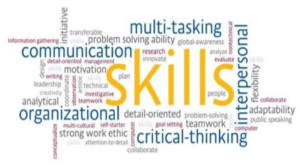 Description: In recent years, there has been a growing expectation that one can measure, with precision and accuracy, the many positive personal qualities other than cognitive ability that contribute to student wellbeing and achievement. Four broad approaches to the assessment of generic skills have been identified: holistic judgments by teachers, portfolios created by students, assessment based on work experience, and assessment using purpose-developed instruments, each of them with its advantages and limitations according to the purposes of program evaluation, accountability, individual diagnosis, and practice improvement .
Description: In recent years, there has been a growing expectation that one can measure, with precision and accuracy, the many positive personal qualities other than cognitive ability that contribute to student wellbeing and achievement. Four broad approaches to the assessment of generic skills have been identified: holistic judgments by teachers, portfolios created by students, assessment based on work experience, and assessment using purpose-developed instruments, each of them with its advantages and limitations according to the purposes of program evaluation, accountability, individual diagnosis, and practice improvement .
Benefits: Among other things, a sound approach to the assessment of skills will provide:
- a means of providing feedback to learners on their acquisition of generic skills and a framework for their improvement
- a mechanism for communicating the scope of generic skills to learners, training providers and employers, providing a rich source of information about individual achievement, with supportive evidence
- an opportunity to undertake authentic assessments which occur within a work context or one that closely simulates it
- a summary of the performance of individuals readily accessible by employers
- a cost-effective means of collecting performance information, individually and at aggregate (institutional and system) levels.
Challenges: Since the inception of key competencies, their assessment has been a challenging issue for practitioners. On the one hand there is a lack of clarity about individual constructs of each generic skill. In addition, the evidence on transfer and the ability to apply a skill in different contexts is difficult to attain. Progression is another big issue and the identification of levels of performance is far from resolved. Each measurement tool has its advantages and limitations, so that the accuracy of data obtained could be questionable. Finally, we still do not know how to act on data regarding the personal qualities of students in various classrooms or schools.
Applied to entrepreneurial education: While a variety of methods has been used in the summative assessment of generic and/or entrepreneurial skills, there would appear to be a role for formative assessment methods that seek to assist student learning and enhance generic skills performance. A combination of different measures including self-report questionnaires, teacher-report questionnaires, performance tasks and portfolio assessment may produce a more accurate picture of progress in students’ ability and disposition to use such skills. In the classroom the teacher must ensure that they signal key elements of entrepreneurial skills and encourage students to analyse their use of the skills and to contemplate alternative situations in which it might be applicable.
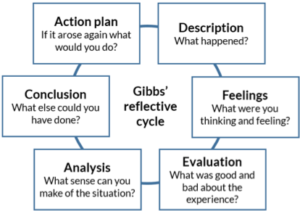 Description: Reflective assessment is a method that belongs to the formative assessment family of methods, although it can be used summatively. It is about assessment primarily for the purpose of improving learning. It is further an active and empowering assessment method since it engages the student in self-evaluation and self-reflection. It leans theoretically on the crucial role that meta-cognition plays in learning, in that it asks students to think about their own thinking. Gibbs has specified a cycle of six steps in reflective learning that is often applied when teachers design reflective assessment . Some ways to implement reflective assessment include, for example, asking students to write down “I learned” statements, asking for an oral “turn and talk” with the student next to them, asking students to write down what is clear and unclear from the lesson on a piece of paper, and asking students to compose a journal / dairy.
Description: Reflective assessment is a method that belongs to the formative assessment family of methods, although it can be used summatively. It is about assessment primarily for the purpose of improving learning. It is further an active and empowering assessment method since it engages the student in self-evaluation and self-reflection. It leans theoretically on the crucial role that meta-cognition plays in learning, in that it asks students to think about their own thinking. Gibbs has specified a cycle of six steps in reflective learning that is often applied when teachers design reflective assessment . Some ways to implement reflective assessment include, for example, asking students to write down “I learned” statements, asking for an oral “turn and talk” with the student next to them, asking students to write down what is clear and unclear from the lesson on a piece of paper, and asking students to compose a journal / dairy.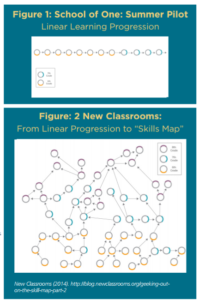 Definition: A learning progression is a carefully sequenced set of building blocks that students must master en route to a more distant curricular aim. They map out commonly travelled paths that students take.
Definition: A learning progression is a carefully sequenced set of building blocks that students must master en route to a more distant curricular aim. They map out commonly travelled paths that students take.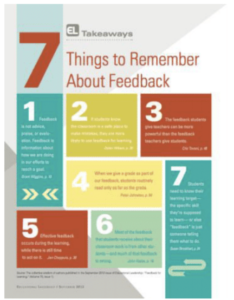
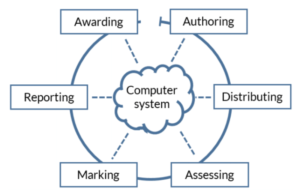 Description: E-assessment ranges from simple computer-based tests with multiple-choice questions to complex and multimedia rich simulations, games, case studies and e-portfolios. It thus encompasses a broad range of assessment methods used in computer-based learning environments, often termed ‘E-learning’. E-assessment can be used both for high-stakes and for low-stakes testing, as well as both for summative and formative assessment. Teachers can distribute questions and tasks as well as collect and analyse student responses. Some marking can be automated.
Description: E-assessment ranges from simple computer-based tests with multiple-choice questions to complex and multimedia rich simulations, games, case studies and e-portfolios. It thus encompasses a broad range of assessment methods used in computer-based learning environments, often termed ‘E-learning’. E-assessment can be used both for high-stakes and for low-stakes testing, as well as both for summative and formative assessment. Teachers can distribute questions and tasks as well as collect and analyse student responses. Some marking can be automated.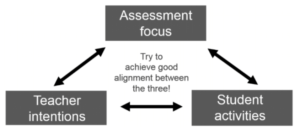 Benefits: Constructive alignment requires teachers to reflect upon what it means to understand a subject on a deep level, and how students can attain such a deeper understanding. By asking teachers to state those verbs that describe necessary learning activities for students, a gap between abstract theoretical knowledge and personal competent practice can be bridged. This increases consistency, improves educational effectiveness and minimises ineffective surface learning.
Benefits: Constructive alignment requires teachers to reflect upon what it means to understand a subject on a deep level, and how students can attain such a deeper understanding. By asking teachers to state those verbs that describe necessary learning activities for students, a gap between abstract theoretical knowledge and personal competent practice can be bridged. This increases consistency, improves educational effectiveness and minimises ineffective surface learning.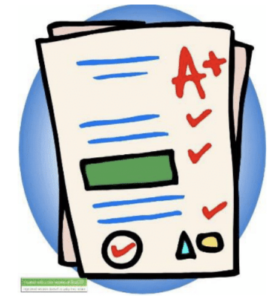 Benefits: The benefits of assessment of learning to the learner are that it requires teachers to use transparent approaches and to interpret the outcomes of learning in a standardised way so that students are able to demonstrate their knowledge, competence and skills level at a particular point in time and to be rewarded for that achievement. The rewards associated with assessment of learning provide defensible public reference points for making judgements about an educational approach or system as a whole and the process of assessment of learning provides strategies for recourse in the event of disagreement about end decisions.
Benefits: The benefits of assessment of learning to the learner are that it requires teachers to use transparent approaches and to interpret the outcomes of learning in a standardised way so that students are able to demonstrate their knowledge, competence and skills level at a particular point in time and to be rewarded for that achievement. The rewards associated with assessment of learning provide defensible public reference points for making judgements about an educational approach or system as a whole and the process of assessment of learning provides strategies for recourse in the event of disagreement about end decisions.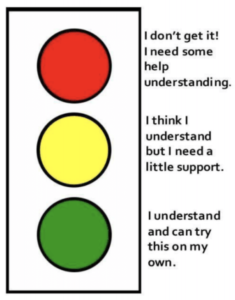 Benefits: Assessment for Learning (AfL) is an essential part of a learner’s education as it defines whether or not the objectives of teaching are being met. Assessment affects decisions about grades, educational needs of learners and in some cases funding. AfL is a significant way to raise a learner’s academic achievement and is centred on the belief that in order for learners to progress then they must understand the purpose of their learning, where they are in relation to that purpose and how they can achieve their goals. AfL helps a learner reflect on their own development which in turn helps them to recognise and appreciate their own strengths as well as developing an insight into themselves as a learner. If a learner is given the opportunity to discuss their learning either with a teacher or one of their peers then they will develop a deeper understanding of their learning which can build confidence and motivate them as students. Effective AfL identifies individual educational needs as well as informing the learner about their specific performance and achievements, allowing teachers to utilise approaches that are personalised to the needs of learners. AfL can be used not only to measure learning but also to promote learning by teaching learners how to ask questions as well as answering them, by emphasising to a learner that it is acceptable to ‘Have a go’ and that giving the wrong answer it is still learning.
Benefits: Assessment for Learning (AfL) is an essential part of a learner’s education as it defines whether or not the objectives of teaching are being met. Assessment affects decisions about grades, educational needs of learners and in some cases funding. AfL is a significant way to raise a learner’s academic achievement and is centred on the belief that in order for learners to progress then they must understand the purpose of their learning, where they are in relation to that purpose and how they can achieve their goals. AfL helps a learner reflect on their own development which in turn helps them to recognise and appreciate their own strengths as well as developing an insight into themselves as a learner. If a learner is given the opportunity to discuss their learning either with a teacher or one of their peers then they will develop a deeper understanding of their learning which can build confidence and motivate them as students. Effective AfL identifies individual educational needs as well as informing the learner about their specific performance and achievements, allowing teachers to utilise approaches that are personalised to the needs of learners. AfL can be used not only to measure learning but also to promote learning by teaching learners how to ask questions as well as answering them, by emphasising to a learner that it is acceptable to ‘Have a go’ and that giving the wrong answer it is still learning.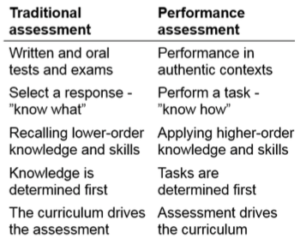 Definition: Let students perform meaningful and hands-on real-life tasks and assess them based on their task accomplishment1.
Definition: Let students perform meaningful and hands-on real-life tasks and assess them based on their task accomplishment1.